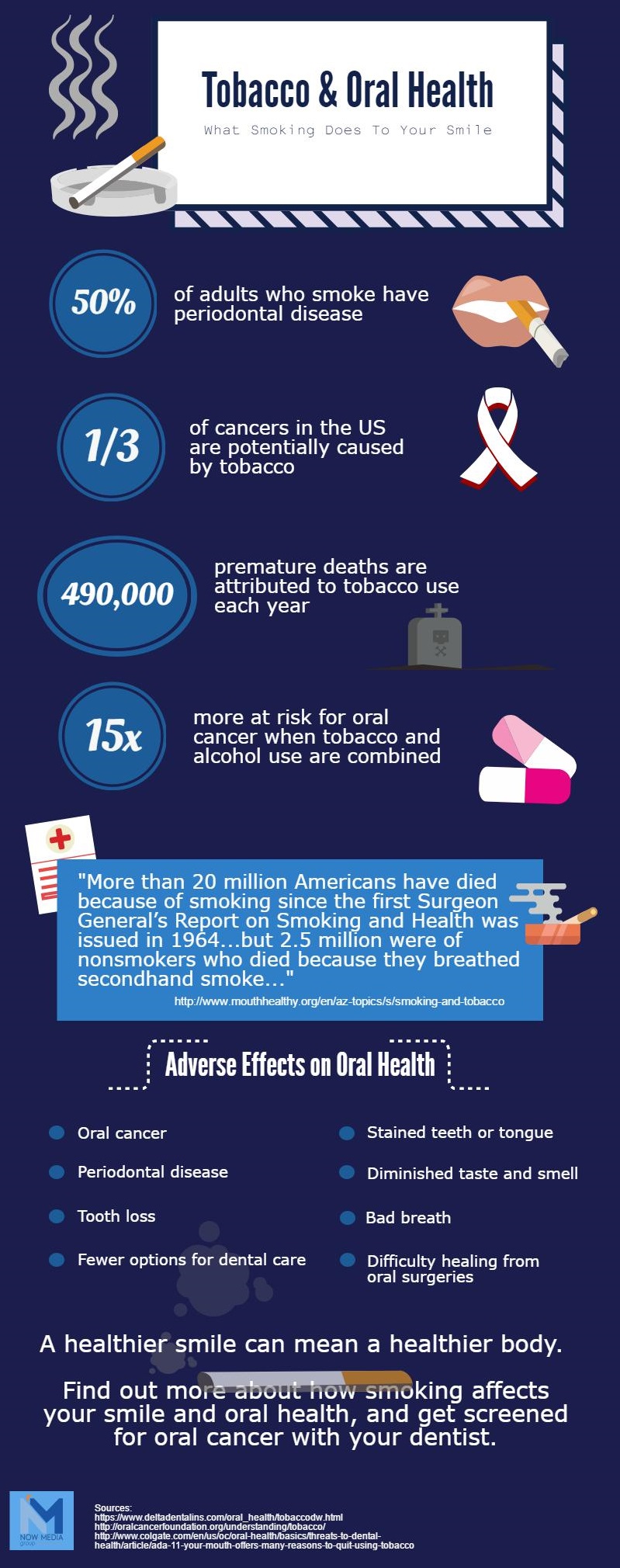Since it was first linked to lung cancer in the 1950’s, the evidence of harm caused by tobacco has expanded each year. Not only has cigarette smoke been found to harm many parts of the body, but even non-smokers who are exposed to it have been known to develop cancer. As if more reason was needed to quit this injurious habit, tobacco is extremely harmful to your oral health as well.
A Wide Range Of Damage
If you’re a smoker who has no intention of quitting, your oral health is susceptible to a wide range of damage. Obviously the level of your dental care plays a key role in the harm you experience, but some of the conditions caused by tobacco can’t be solved by a simple brushing. For example, the bad breath experienced by smokers is caused by their inhalation and exhalation of toxic smoke, and therefore can’t be fixed by any other method but quitting tobacco.
Mild Affects Of Tobacco On Oral Health
Some of the effects smokers experience in their mouths are more of a daily nuisance than they are fatal. Spanning the gap from dark tooth stains to a hairy tongue, each of these are annoying conditions that can evolve into far worse problems if smoking continues.
Teeth Staining
The telltale sign of a frequent smoker is a set of teeth that are several shades darker than they should be. While staining is also caused by products like wine and coffee, the consistent inhalation of toxic smoke makes smoking a prime culprit in darkening the teeth. There are two forms of tooth staining known as outer and intrinsic, and tobacco use is known to only cause the outer variation of staining. This means that quitting tobacco use can help restore your smile to what it once was.
Bad Breath/Halitosis
Another non-lethal oral health condition caused by tobacco is halitosis, more commonly known as bad breath. While not harmful to physical health, bad breath is an unwanted condition that can negatively impact social interactions. Bad breath can affect anything from work meetings to family gatherings, and it’s the people who are around you frequently that suffer most. Quit smoking to eliminate one of the leading causes of halitosis.
Hairy Tongue
Teeth aren’t the only part of your mouth that can experience discoloration due to smoking. Those who smoke may see their tongue become so discolored that it appears to have a pelt of hair growing on it. When excessive bacteria gathers on the tongue, it can cause it to stop discarding dead cells, resulting in a thick dark stain on the tongue. This is what provides the hairy appearance, and although harmless, the condition of black hairy tongue is widely considered to be gross and disturbing.
Severe Effects Of Tobacco On Oral Health
As shown above, not all of the effects of tobacco on the mouth are lethal, but some are. Those who refuse to quit smoking are likely to see some of the more severe forms of damage from tobacco products. Here are some of the serious dental conditions that arise in those who continue using tobacco:
Failure Of Dental Implants
Dental implant placement is a procedure that boasts a 98% success rate, but smoking can greatly increase your chances of failure. The main reason that smoking is one of the worst things you can do if you’re a dental implant patient is that it prolongs the healing process. Since a major part of dental implant placement is the 4-months of healing while osseointegration takes place, complications in healing make dental implant surgery more likely to fail.
Considering the price and time requirements, it’s easy to see how dental implant failure is undesirable for everyone involved. That’s the main reason why hardcore smokers may be disqualified as candidates for dental implant surgery.
ANUG (Acute necrotizing ulcerative gingivitis)
ANUG is a rare type of gingivitis that is caused by excessive smoking. The condition earned the nickname trench mouth, due to its prevalence among soldiers in World War 1. Characterized by inflammation and ulcers in the gums that resemble craters, ANUG is a disease that can be managed by cutting back on smoking and boosting oral care.
Oral Cancer
As the most devastating dental disease caused by smoking, it’s estimated that oral cancer will cause 9,750 deaths this year. The major reason why oral cancer kills so many people is because it’s often discovered late into the disease when treatment options are limited. With toxic fumes circulating around the mouth on a daily basis, smoking plays a key role in developing oral cancer.
Chewing Tobacco: Another Form Of Poison
While smoking is the most popular form of tobacco use, it’s not the only one. Going by names like dip and chew, chewing tobacco is also a potent product that causes a lot of health problems. Since the tobacco is smooshed between the inner mouth and the gums, those who use chewing tobacco are at a high risk for gum damage, including gingivitis and periodontitis.
Another unique result of chewing tobacco on the mouth is that it leaves white precancerous mouth lesions, which are essentially blisters that can develop into cancer. With a slew of devastating ailments caused by chewing tobacco, it’s easy to see that it’s just as harmful to your oral health as smoking.

Call Dr. Richard Grubb To Set Up An Appointment Today!
Smoking or chewing tobacco are among the most destructive things you can do to your teeth. Even if you follow proper oral care habits, the damage caused by smoking and dipping can transcend your efforts, leaving you with a disastrous combination of problems. Prevent this by contacting Dr. Richard Grubb with your dental concerns, and together we’ll come up with a plan to improve your dental health.
Bibliography Of Related Links
- Useful statistics on halitosis
- View additional details on black hairy tongue
- Learn more about trench mouth, also called ANUG
- Read alarming stats on oral cancer
- Peruse the devastating effects of chewing tobacco
